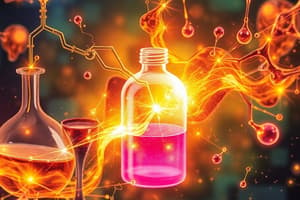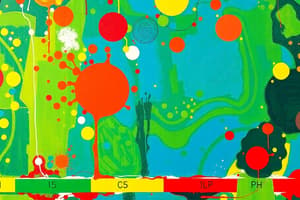Podcast
Questions and Answers
Match the following alkyl halide classifications with their reactivity order:
Match the following alkyl halide classifications with their reactivity order:
Primary = Least reactive Secondary = Moderately reactive Tertiary = Highly reactive Quaternary = No reactivity
Match the following alkyl halides with their boiling point and melting point trends:
Match the following alkyl halides with their boiling point and melting point trends:
Methyl iodide = Lowest boiling point and melting point Ethyl bromide = Moderate boiling point and melting point Isopropyl chloride = Higher boiling point and melting point Tert-butyl fluoride = Highest boiling point and melting point
Match the following alkyl halides with their solubility in water:
Match the following alkyl halides with their solubility in water:
Methyl chloride = Slightly soluble in water Ethyl bromide = Insoluble in water Isopropyl fluoride = Partially soluble in water Tert-butyl iodide = Very low solubility in water
Match the following alkyl halides with their chemical reactivity based on leaving group strength:
Match the following alkyl halides with their chemical reactivity based on leaving group strength:
Match the following alkyl groups with their effect on acidity:
Match the following alkyl groups with their effect on acidity:
Match the following with their primary usage:
Match the following with their primary usage:
Match the following with their relevance to alkyl halides in pharmaceuticals:
Match the following with their relevance to alkyl halides in pharmaceuticals:
Match the following with their relation to alkyl halides and chemical reactivity:
Match the following with their relation to alkyl halides and chemical reactivity:
Match the following with their relevance to alkyl halides in terms of classification:
Match the following with their relevance to alkyl halides in terms of classification:
Match the following with their relation to alkyl halides and solubility:
Match the following with their relation to alkyl halides and solubility:
Match the alkyl halide classification with the correct description:
Match the alkyl halide classification with the correct description:
Match the following with their correct trends for boiling and melting points:
Match the following with their correct trends for boiling and melting points:
Match the solubility trend of alkyl halides with regard to polar and non-polar solvents:
Match the solubility trend of alkyl halides with regard to polar and non-polar solvents:
Match the acidity trend of alkyl halides with increasing number of alkyl groups attached:
Match the acidity trend of alkyl halides with increasing number of alkyl groups attached:
Match the chemical reactivity trend of alkyl halides with increasing number of attached alkyl groups:
Match the chemical reactivity trend of alkyl halides with increasing number of attached alkyl groups:




